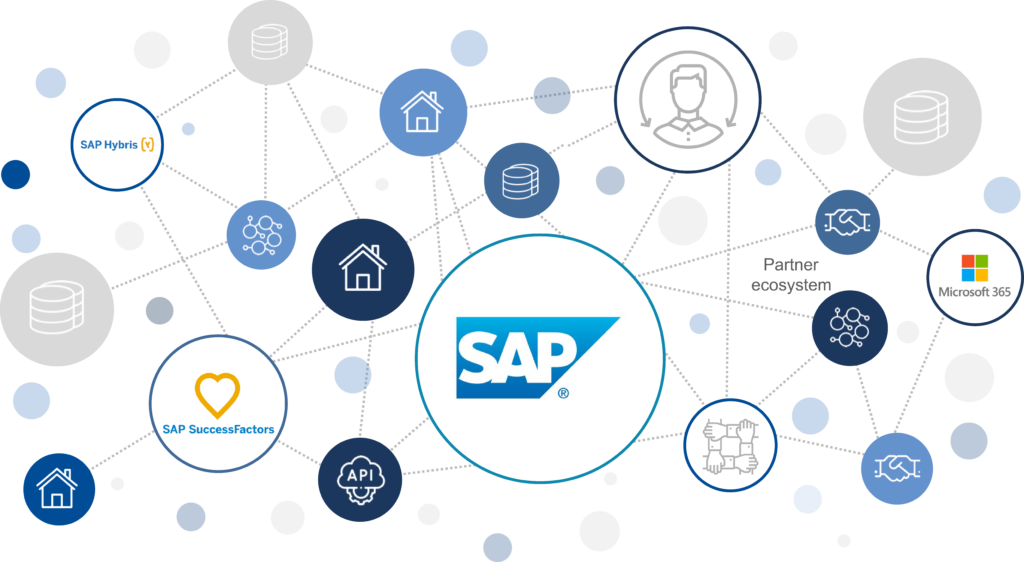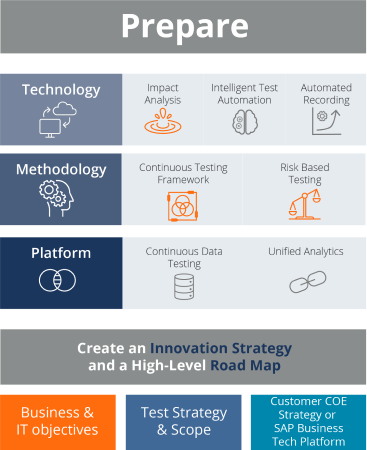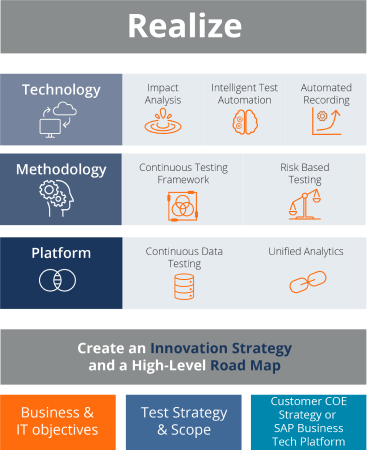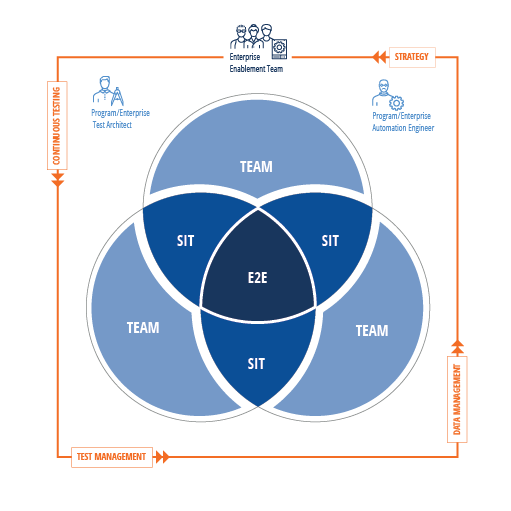Introduction
The SAP environment and applications form the technology hub for many organizations. Out of the world’s 500 largest companies, 94 percent are SAP customers. The typical enterprise portfolio includes 2,000 to 3,000 applications in production—and an average transaction touches 83 different technologies.

This complex, dynamic IT landscape presents significant challenges for QA teams. In joint research conducted by ASUG and Tricentis in August 2020, we found that:
- 51% Believe updating SAP systems puts business processes at risk
- 46% Report that updates take longer than desirable
- 41% Are concerned about the cost associated with updating SAP
The good news is that there are technologies and methodologies that can minimize the risk of maintaining, upgrading, or migrating your SAP implementation. Here are the steps to taking control of your SAP QA processes.
This article will describe how you can accelerate your SAP QA processes by using the right strategies and tools provided in the Continuous Testing Framework and with SAP Activate.
SAP Activate is a development methodology designed to help you implement your SAP solutions. Within this set of practices, RISE with SAP can help you get up and running with cloud SAP solutions.
As you use RISE with SAP, you will want testing and quality assurance to be an efficient part of your efforts. To that end, we have overlayed the capabilities of the Continuous Testing Framework (CTF) with the RISE with SAP methodology to help you bring testing tools into your delivery process as early as possible.

1
Take advantage of technical solutions
The evolution of the process starts when you use technical solutions to help you orchestrate QA efficiently, so that you will be fully aware of the changes and the impact they will have.
New technologies can help you speed up QA towards more agile testing, enabling greater innovation, faster time to market, higher quality, and lower costs. In the process, you will also:
- De-risk your SAP RISE transformations.
- Accelerate delivery timelines for faster business value.
- Decrease QA costs across the entire process landscape.
In a typical software delivery cycle, teams start with designing and developing before performing impact analysis, continuous test automation, and load testing. But according to ASUG and Tricentis’ research, 49 percent of organizations say the QA phase slows down SAP releases and 45 percent report that the business requirements and planning phase causes a similar drag. To eliminate these common delays, it’s important to determine exactly what to test.
This can be either done manually or with the help of new technical solutions which can be seamlessly integrated into your SAP quality assurance or delivery pipeline. No matter which type of project you’re running, identifying your business risks early in the process is crucial. By making use of modern technology, you will decrease manual analysis efforts significantly and deliver business value.
This applies to each of the following types of projects:
- Staying fit. Keeping current with upgrades, support packs, and EHPs; making major and minor change releases; performing daily and weekly transports; and making legal and regulatory changes as needed.
- Getting ready. Preparing for S/4HANA digital transformation projects.
- Making the move. Migrating resources within a digital transformation project.
One of the biggest benefits technical solutions can deliver in your projects is to help you detect all changes with every check-in. You can detect all changes to your SAP landscape automatically, whether they are ABAP, security, contract, or code changes. Doing so enables you to shift testing left and increase transparency throughout the software delivery lifecycle, which helps you shorten lead times, decrease effort, and generate business value as quickly as possible.
By analyzing your SAP instances automatically to identify changes, you will immediately benefit from:
- Reduced scope of testing. Your testers will be able to focus on your most used, most critical, and most changed areas.
- Removed dead code and reduced technical debt. Avoid testing of unused areas in your landscape and efficiently orchestrate your resources through the testing cycle.
- Increased quality. Your teams can get the insights they need to make data-driven decisions, reduce hypercare, and orchestrate your QA activities.
Furthermore, by combining advanced technologies you will elevate your SAP QA practice. You can improve your delivery process at every stage by deeply integrating the following capabilities into your delivery pipeline:
- Smart impact analysis
- Intelligent test automation
- Enterprise performance testing
- Automated and continuous data testing
- Unified analytics

2
Make qualified data-driven decisions
Modern technology can also help teams integrate the output of all their activities so that they can collect the data they need to make data-driven decisions about quality. The various QA activities throughout the SAP landscape generate vast amounts of data. Within this data are insights that can help you:
Conduct analysis to determine exactly what to test, including:
- Types of coverage
- Types of usage
- Impact analysis
- Amount of dead code
Assess the release readiness of an application and the overall health of your quality assurance processes in terms of:
- Code quality
- Number of bugs
- Number of incidents
- System performance
Gauge the impact of your QA processes and measure the business value they create in terms of:
- Team performance
- Team velocity
- Team ROI
Based on this information, you can begin to determine whether a release candidate has an acceptable level of risk—and whether SAP updates will undermine business continuity.

3
Deliver more value with streamlined approaches
Implementing the right technology and analyzing the right data are essential steps in evolving your SAP QA practice. But it’s also critical to execute these strategies as efficiently as possible. The best way to do that will depend on your organizational structure. Some organizations maintain a classic hierarchy, while others have adopted a matrix approach. Still others have devised unique organizational models.
This doesn’t mean that differently structured organizations need to take vastly different approaches to QA. One of the biggest advantages of CTF is that it’s designed to work in virtually any organizational structure. Companies can easily implement CTF for SAP Activate for RISE—SAP’s methodology for deploying, adopting, and extending new capabilities. The implementation will take place in several key phases.
Discover
The first discovery assessment should begin during application design and configuration. It is never too early to start thinking about quality assurance. One objective is to create an innovation strategy and a high-level roadmap to enable business and IT objectives. The priority for your QA in this phase is to outline the test strategy & scope and enable the sap business technology platform.
During the Discover phase, your team will contribute and define the guardrails by designing the high-level test architecture for continuous testing, test management, data management, and the overall testing strategy to be in line with SAPs application design and configuration during this phase. You can also calibrate your strategy to incorporate AI, automation, and cloud technologies.

Prepare
During the Prepare phase, the Enterprise Enablement Team—a team of highly skilled QA experts—takes a leadership role in terms of strategy and operational tasks. The team will provide the initial planning and preparation for the testing stream by enabling on test management, QA tools.
In detail, the Enterprise Enablement Team will focus on tasks such as:
- Refining the strategy and establishing standards and governance by utilizing the Continuous Testing Framework and risk based testing.
- Finalizing QA tools by integrating them into the existing infrastructure.
- Customer team self-enablement on QA tools.
- Fit to standard system preparation – Analyze the impact of special coding and configuration activity needed to support baseline processes.

Explore
In the Explore phase, the bulk of strategic and tactical responsibility shifts to the Program Test Architect who will develop detailed plans to cover all aspects of the implementation. The Program Test Architect will also make key decisions about the amount and type of test data needed, reporting capabilities, unified analytics, and other key elements of test planning.
The Program Test Architect may also:
- Decrease manual efforts by leveraging and integrating impact analysis.
- Derive test scope and scenarios from analysis.
- Ensure that business process experts are enabled to automatically record business processes so that databases will quickly fill up with valuable knowledge that can be converted into test cases.
- Determine high-level regression portfolios.
- Prepare and integrate test automation solution.

Realize
The Realize phase consists of test preparation and test execution – preparing scenarios, cases, data and the actual tests by utilizing automation and integrated analysis and reporting. These activities happen within teams, across teams, or at a highly integrated end-to-end level. For any organization that wants to increase speed and quality without exploding costs at the Realize phase, automation at all levels is a must.
Teams should now use all the tools, methodology, and platform at their disposal to execute their testing strategies. Automation Specialists and Analysts will execute all the plans made for QA, impact analysis, automated testing, and analysis and reporting.


4
What a healthy SAP testing cycle looks like
How can incorporating CTF into your SAP testing cycle lead to better results? Consider the impact from the very beginning of a delivery when a developer is writing code. This activity can often be a black box in the sense that team members have no visibility into changes and tests..
This is where teams can leverage smart impact analysis to reduce their manual efforts and identify dead code and technical debts. With this information, developer can focus on writing code and running automated ABAP tests. Teams that do this continuously and integrate it into the delivery pipeline can massively increase quality and transparency and streamline efforts.
Here’s what happens at each level of testing:
- Unit level. The testing cycle begins with a developer performing unit testing. As part of a team, this developer will use intelligent test automation for API tests. Together, the team will perform impact analysis to identify dead code and therefore reduce test scope, build automated tests for ABAP changes, and determine code quality for custom development.
- System Testing level. System testing will take place at the team level, performed by the Test Analyst and Automation Specialist. These team members will use impact analysis to plan the test scope by identifying which items have changed. They’ll determine which are the most used and most at-risk items so that they can build and execute their automated tests. The result is intelligent test automation that’s linked to unified analytics and creates useful data points for reporting.
- System Integration level. During system integration testing, the System Team takes responsibility and uses many of the techniques and assets left behind by teams earlier in the testing cycle. The System Team will rely heavily on impact analysis, intelligent test automation, and unified analytics. They’ll examine what has changed from version to version in the code and configuration delivered by various teams across the organization. After using this information to determine the scope of their testing, they’ll assemble their system integration tests. Like earlier teams, the System Team will perform smart impact analysis and automate the test scenarios, custom code, and API, or work with service virtualization.
- End-to-End level. The System Team is again responsible for end-to-end testing and will follow a methodology much like that of previous levels. The team will run impact analysis to determine what has changed, implement intelligent test automation, and use automated recording to gather data. Throughout this phase, the System Team will implement increasingly complex tests, but will use modern technology to ensure efficiency and keep the application on track for a timely release.
- User Acceptance and Production level. At this final level of testing, business process experts and the System Team are performing and orchestrating user acceptance and production tests. Because of all the quality assurance improvements implemented at earlier stages of testing, the overall quality should be high at this stage, with minimal hypercare needed. While bugs may still occur, time to fix will be minimal. By implementing automation such as smart impact analysis, teams can dramatically accelerate root cause analysis. Modern technology can also help teams speed up traditionally effort-heavy audits such as SOX and SOD. It is typically soon after the User Acceptance and Production level of testing that teams can ship their deliveries to production.

5
Take Control of Your Software Test Cycle
Any organization that’s serious about optimizing their SAP quality assurance for faster, higher quality deliveries should focus on:
- Deploying technical solutions such as AI and automation anywhere it makes sense.
- Make data-driven decisions by gathering and analyzing data.
- Continually streamlining processes to deliver greater and greater value.
The Continuous Testing Framework is designed to help organizations accomplish all three of these goals and is complementary to SAP Activate for RISE. It incorporates the latest testing technologies, encourages the integration of data from all testing systems, and shifts testing left so that all later stages of testing will be as efficient as possible.
LEARN MORE ABOUT EVOLVING YOUR SAP QA

